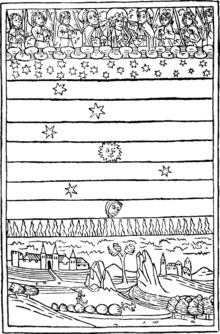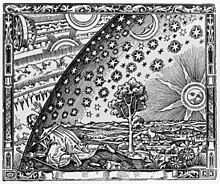| Revision as of 20:39, 26 October 2017 editCarcht (talk | contribs)8 edits →See also: relevance?← Previous edit | Revision as of 11:13, 27 October 2017 edit undoForestsoceansmusic (talk | contribs)37 editsNo edit summaryNext edit → | ||
| Line 1: | Line 1: | ||
| ] | ] | ||
| In ], the '''firmament''' is the structure above the atmosphere, conceived as a vast solid dome |
In ], the '''firmament''' is the structure above the atmosphere, conceived as a vast solid dome,<ref name="NewAdvent">{{CathEncy|wstitle=Firmament|noicon=x}}</ref> but as the footnote shows, this is only the opinion of the 1913 Roman Catholic "Encyclopedia". For an alternate discussion on the '''firmament''', see https://answersingenesis.org/astronomy/cosmology/is-the-raqiya-firmament-a-solid-dome/. | ||
| According to the ], God created the firmament to separate the "waters above" the earth from the "waters below" the earth.<ref>"And God said, Let there be a firmament in the midst of the waters, and let it divide the waters from the waters"{{cite web|url=http://biblehub.com/genesis/1-6.htm |title= Genesis 1:6 |date= |work= |publisher= |accessdate=}}</ref> The word is anglicized from Latin ''firmamentum'', which appears in the ], a late fourth-century Latin translation of the Bible. | |||
| ==Biblical use== | ==Biblical use== | ||
Revision as of 11:13, 27 October 2017

In Biblical cosmology, the firmament is the structure above the atmosphere, conceived as a vast solid dome, but as the footnote shows, this is only the opinion of the 1913 Roman Catholic "Encyclopedia". For an alternate discussion on the firmament, see https://answersingenesis.org/astronomy/cosmology/is-the-raqiya-firmament-a-solid-dome/. According to the Genesis creation narrative, God created the firmament to separate the "waters above" the earth from the "waters below" the earth. The word is anglicized from Latin firmamentum, which appears in the Vulgate, a late fourth-century Latin translation of the Bible.
Biblical use
Main article: Biblical cosmologyThe firmament is described in Genesis 1:6–8 in the Genesis creation narrative:
Then God said, “Let there be a firmament in the midst of the waters, and let it divide the waters from the waters.” Thus God made the firmament, and divided the waters which were under the firmament from the waters which were above the firmament; and it was so. And God called the firmament Heaven. So the evening and the morning were the second day.
Etymology
The word "firmament" is first recorded in a Middle English narrative based on scripture dated 1250. It later appeared in the King James Bible. The word is anglicised from Latin firmamentum, used in the Vulgate (4th century). This in turn is derived from the Latin root firmus, a cognate with "firm". The word is a Latinization of the Greek stereōma, which appears in the Septuagint (c. 200 BC).
History
Main article: Hebrew astronomy § Biblical cosmology
The word "firmament" is used to translate rāqîaʿ (רָקִ֫יעַ), a word used in Biblical Hebrew. It is derived from the root raqqəʿ (רָקַע), meaning "to beat or spread out", e.g., the process of making a dish by hammering thin a lump of metal.
Like most ancient peoples, the Hebrews believed the sky was a solid dome with the Sun, Moon, planets and stars embedded in it. According to The Jewish Encyclopedia:
The Hebrews regarded the earth as a plain or a hill figured like a hemisphere, swimming on water. Over this is arched the solid vault of heaven. To this vault are fastened the lights, the stars. So slight is this elevation that birds may rise to it and fly along its expanse.
Augustine wrote that too much learning had been expended on the nature of the firmament. "We may understand this name as given to indicate not it is motionless but that it is solid." he wrote. Saint Basil argued for a fluid firmament. According to St. Thomas Aquinas, the firmament had a "solid nature" and stood above a "region of fire, wherein all vapor must be consumed."
The Copernican Revolution of the 16th century led to reconsideration of these matters. In 1554, John Calvin proposed that "firmament" be interpreted as clouds. "He who would learn astronomy and other recondite arts, let him go elsewhere," wrote Calvin. "As it became a theologian, had to respect us rather than the stars," Calvin wrote. Calvin's doctrine of accommodation allowed Protestants to accept the findings of science without rejecting the authority of scripture.
Scientific development
Main article: Celestial spheresThe Greeks and Stoics adopted a model of celestial spheres after the discovery of the spherical Earth in the 4th to 3rd centuries BC. The Medieval Scholastics adopted a cosmology that fused the ideas of the Greek philosophers Aristotle and Ptolemy. This cosmology involved celestial orbs, nested concentrically inside one another, with the earth at the center. The outermost orb contained the stars and the term firmament was then transferred to this orb. There were seven inner orbs for the seven wanderers of the sky, and their ordering is preserved in the naming of the days of the week.
Even Copernicus' heliocentric model included an outer sphere that held the stars (and by having the earth rotate daily on its axis it allowed the firmament to be completely stationary). Tycho Brahe's studies of the nova of 1572 and the comet of 1577 were the first major challenges to the idea that orbs existed as solid, incorruptible, material objects.
In 1584, Giordano Bruno proposed a cosmology without firmament: an infinite universe in which the stars are actually suns with their own planetary systems. After Galileo began using a telescope to examine the sky, it became harder to argue that the heavens were perfect, as Aristotelian philosophy required. By 1630, the concept of solid orbs was no longer dominant.
See also
References
- ^ Herbermann, Charles, ed. (1913). "Firmament". Catholic Encyclopedia. New York: Robert Appleton Company.
- "And God said, Let there be a firmament in the midst of the waters, and let it divide the waters from the waters""Genesis 1:6".
- Genesis 1:6–8
- "firmament", Oxford English Dictionary (1989). "ðo god bad ben ðe firmament". From The story of Genesis and Exodus (1250).
- ^ "Online Etymology Dictionary – Firmament".
- "Lexicon Results Strong's H7549 – raqiya`". Blue Letter Bible. Blue Letter Bible. Retrieved 2009-12-04.
- Seely, Paul H. (1991). "The Firmament and the Water Above" (PDF). Westminster Theological Journal. 53: 227–40. Retrieved 2010-02-02.
- "Cosmogony". JewishEncyclopedia.com. Retrieved 2014-05-15.
- ^ Grant, Edward, Planets, stars, and orbs: the medieval cosmos, 1200–1687. p. 335.
- Saint Thomas Aquinas, Summa Theologica, "Whether there are waters above the firmament?"
- ^ Luigi Piccardi, W. Bruce Masse, Myth and geology, p. 40
- Firmament, Catholic Encyclopedia.
- Grant, p. 308.
- Grant, p. 348.
- Giordano Bruno, De l'infinito universo e mondi (On the Infinite Universe and Worlds), 1584.
- Grant, p. 349.
External links
- The Vault of Heaven.
- Denver Radio / YouTube Debate on the Firmament between well-known creationist and atheist opponents.
- The Firmament described in The Blueprint